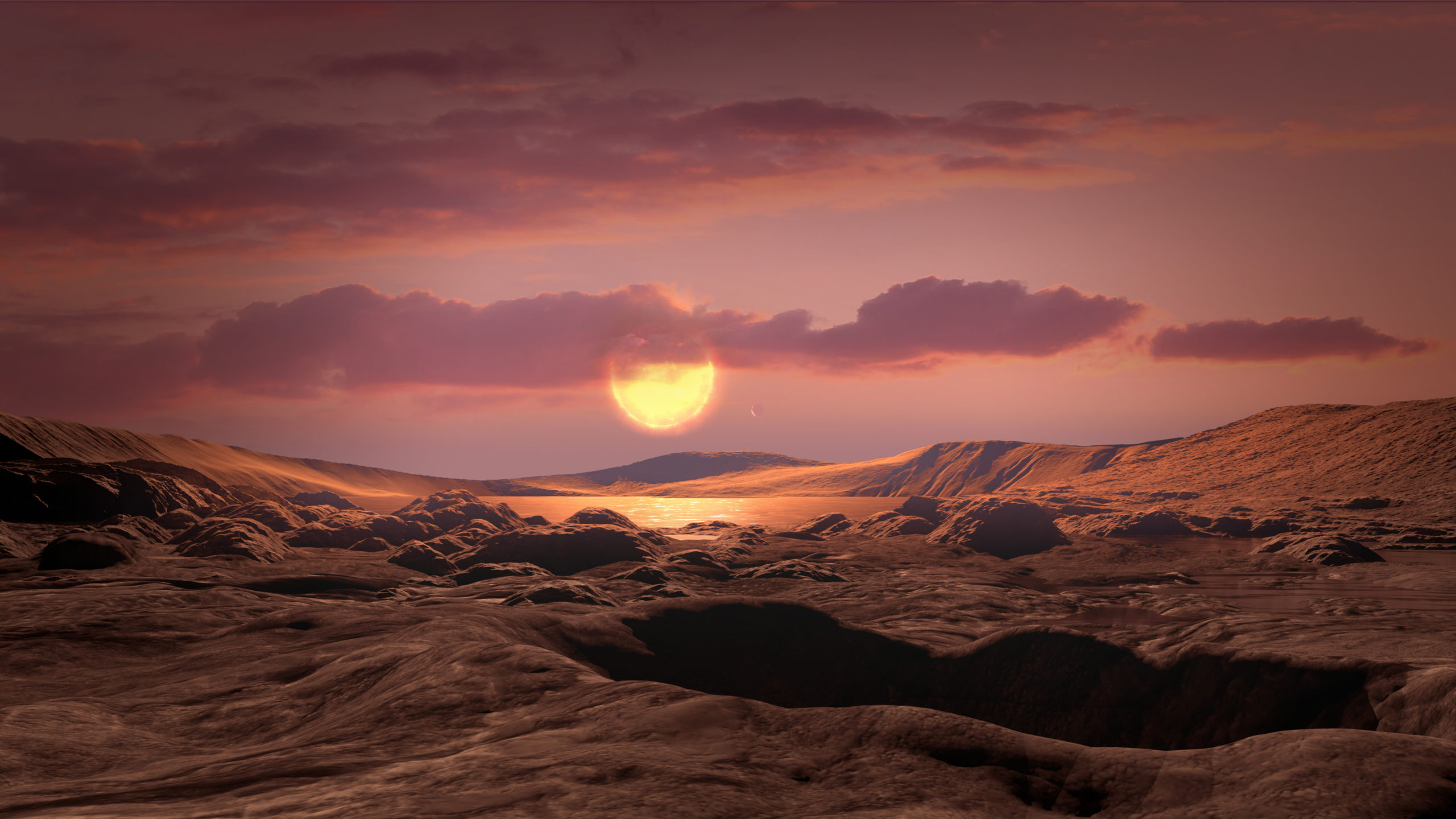The Presidents' Lecture
Whispers from Other Worlds
NASA's Search for Life in the Cosmos
Thomas Zurbuchen & Nadia Drake
Thomas Zurbuchen
Retired Director, Science Mission Directorate
NASA
Nadia Drake
Science Journalist
Sponsored by the IP Law Firm of MWZB, PC
About the Lecture

Whether life exists beyond Earth is among the most exciting — and toughest — mysteries that science can solve. For millennia, humans have wondered whether we are alone in the cosmos, but those musings lived almost exclusively in the realm of philosophy, not science. Sixty years ago, the first scientific search for extraterrestrial technologies was met with curiosity, and at times cynicism and ridicule. Only recently has the search for extraterrestrial intelligence (“SETI”) begun to gain traction and legitimacy among scientists.
Looking for life beyond Earth is now a core motivator and organizing principle for NASA’s science programs. The NASA Authorization Act in 2017 mandated that the space agency make “the search for life’s origin, evolution, distribution, and future in the universe” one of three key exploration objectives. (The other two are to protect and Improve life on Earth and in space, and to explore the secrets of the universe). Finding life beyond Earth is one of NASA’s most challenging goals, and it is one of the most compelling.
This lecture will first frame the discussion of looking for extraterrestrial life in the context of the famed 1961 Drake equation, a framework that connects physical, chemical and biological processes with the development of detectable civilizations within our own galaxy. And, though the Drake equation’s original form has survived unchanged, we will highlight some changes in our understanding and definition of the equation’s variables – modifications that are a direct result of our growing understanding of life’s tenacity on our home world.
Then, adapting a methodology by Neveu’s 2018 paper in Astrobiology, (https://www.ncbi.nlm.nih.gov/pmc/articles/PMC6211372/pdf/ast.2017.1773.pdf)
the lecture will discuss three ways in which NASA’s Science program focuses on identifying signatures of life elsewhere in the universe.
First, by looking at exoplanets (worlds orbiting other stars). Estimates of life’s possible footholds on these worlds are informed by statistical results from space-based missions and detailed spectroscopic observations of planetary atmospheres. This part of the lecture is particularly timely and relevant as we are just getting the first exoplanet spectra from the James Webb Space Telescope, and starting technology development that will enable the Habitable Worlds Explorer, NASA’s next astrophysics flagship mission, designed specifically to study exoplanet atmospheres and to detect possible signatures of life in their spectra.
Second, moving closer to home, NASA’s science program is focused on icy ocean worlds in our own solar system. Whether it is about gaining knowledge of planetary building blocks, or visiting bizarre worlds such as Titan and Europa — moons of Saturn and Jupiter, which might harbor life today — NASA is seeking to gain insights into processes that transcend the boundaries of our own world, and might have given rise to biology elsewhere.
Third, the lecture will focus on Mars, our near-Earth companion. We have a twenty-year-long history of sending rovers to the Martian surface, and together with landers and orbiters to Mars, we have learned that although the planet is harsh and inhospitable by our standards today, it was once warmer and wetter — a place with considerably more promise for lifeforms to evolve and thrive, either on or below its surface, albeit billions of years ago. This research is culminating in the Mars Sample Return, humankind’s first round-trip to another planet, with the goal of delivering curated samples to the best laboratories on Earth.
Finally, the lecture will address NASA’s effort to define the search for techno-signatures — signs of intelligent alien civilizations. While most of these searches have historically targeted radio emissions, the search today has broadened considerably.
Suggested Reading Material
Our Obsession with Mars (National Geographic, Subscription required)
NASA Science Strategy 2020-2024 (NASA Publication)
Project Ozma at 60 (National Geographic, Subscription required)
The Drake Equation at 60 (National Geographic, Subscription required)
The Ladder of Life Detection – Marc Neveu et al. (2018): Astrobiology 18(11): 1375-1402; “The Ladder of Life Detection”; PMID: 29862836 PMCID: PMC6211372 DOI: 10.1089/ast.2017.1773
About the Speaker

Thomas H. Zurbuchen, known in the space community as “Dr. Z,” is the longest continually serving Head of Science at NASA, a post he held from October 2016 through the end of 2022. As NASA Associate Administrator for the Science Mission Directorate, he was responsible for all aspects of NASA leadership in space science. During his tenure NASA launched 37 science missions and stated 54, including the James Webb Space Telescope, two Mars landings, the Ingenuity helicopter, the Parker Solar Probe, and the DART mission. Thomas also conceived and led the Earth System Observatory, an advanced multi-platform observatory that creates a 3D holistic view of the Earth, from bedrock to atmosphere.
Prior to his tenure as Associate Administrator, Thomas was involved in designing and building a variety of space instruments, including the MASS sensor on NASA’s WIND spacecraft and the Fast Imaging Plasma Spectrometer on NASA’s Messenger mission to Mercury. Previously he was Professor of Space Science and Aerospace Engineering at the University of Michigan, where he co-founded the Center for Entrepreneurship.
Thomas is an author on over 200 publications, focused on solar and heliospheric physics, experimental space research, and space systems. Among other honors and awards he is
a Member of the Swiss Academy of Engineering Sciences, recipient of the NASA Outstanding Service Medal, Associate Fellow of the American Institute of Aeronautics and Astronautics, and recipient of the Presidential Rank Award, Distinguished Level.
Nadia Drake is a freelance science journalist and contributing writer at National Geographic. She specializes in covering astronomy, astrophysics and planetary science, as well as anything involving jungles and spiders. Her byline has also appeared in The Atlantic, Nature, The New York Times, Science News, Wired, and Scientific American, for which she recently led coverage of NASA’s Artemis I moon mission.
From an early age, Nadia has been a keen observer of the search for life beyond Earth—a field that is grounded in the early work of her father, Frank Drake. Now, somewhat serendipitously, much of her journalistic work focuses on astrobiology, the search for life’s origins on Earth and beyond. She’s also a member of NASA’s panel that is investigating Unidentified Anomalous Phenomena (UAP).
Nadia frequently travels in search of stories and has reported from the jungles of Peru and Indonesian Borneo, the Arctic Ocean, Mars-on-Earth, a flying telescope, the deserts of the Middle East, and the slumping glaciers at Mt. Kilimanjaro’s summit.
Nadia has won many awards for her work, including recognition from the American Astronomical Society’s divisions of planetary science and high-energy astrophysics.
Nadia earned a BA in biology, psychology, and dance, and a PhD in genetics at Cornell University. She also holds a graduate certificate in science communication from the University of California, Santa Cruz.
Minutes
On February 3, 2023, from the Powell Auditorium of the Cosmos Club in Washington, D.C, and by Zoom webinar broadcast on the PSW Science YouTube channel, President Larry Millstein called the 2,471st meeting of the Society to order at 8:02 p.m. ET. He welcomed new members, and the recording secretary read the minutes of the previous meeting.
President Millstein then introduced the two speakers for the evening, Thomas Zurbuchen, retired director of the science mission directorate at NASA, and Nadia Drake, a science journalist. Their lecture was titled, “Whispers from Other Worlds, NASA’s Search for Life in the Cosmos”
Zurbuchen began by introducing his co-speaker as the daughter of Frank Drake of the Drake equation and commenting that he and Nadia will tell the story about life in the universe like nobody else can. Specifically the two speakers would tell two stories in parallel, the first of the history of imagining life in the universe and the second would be current efforts and progress which NASA has achieved.
The two speakers explained their personal motivations to understanding whether there is life in the universe. Nadia then described how her father came to identify the 7 factors in the Drake equation. The Drake equation calculates the number of detectable civilizations in the Milky Way Galaxy.
The first factor in the Drake Equation, Nadia explained, is the average rate of star formation. This value was the only known value at the time her father developed the equation in 1961. The following two factors are the fraction of those stars with planets and the average number of those planets that may develop an ecosystem. In the past 2 decades the Kepler mission enabled scientist to determine that on average every star has at least one planet orbiting it.
Nadia then went on to discuss the next two factors; the third is the average number of habitable planets per planetary system, and the fourth is the fraction of those planets that succeed in developing life. She then comments on biosignatures and how they can be used in the identification of this fourth factor.
Zurbuchen then went on to describe the bulk of NASAs science missions and programs which are focused on figuring out the value of the fourth variable.
He began by introducing the Viking mission as a 2 missions which orbited then orbited then landed on Mars, then discussed the addition of language into NASA’s Authorization Law in 2017 which legally obligates NASA to Search for life’s origin, evolution, distribution and the future in the universe.
Next, Zurbuchen reviewed through the ladder of life detection and discussed experiments for exoplanet identification, experiments to identify life in icy bodies, and experiments to find life on mars.
Nadia then reviewed the 5th and sixth factors which are the fraction of those planets with life that developed intelligent life and the fraction of those planets with intelligent life that develop interstellar communication. SETI, she explains, has a 100 million dollar, 10-year search for radio techno signatures called the breakthrough listen in order assist with solving for these two factors.
Zurbuchen went on to discuss this initiative and reviewed different funding mechanisms both inside and outside of the government for doing such research.
Nadia reviewed the last factor, which is the average length of time such civilizations survive and continue to send communications. She confessed that her father was bothered by this factor because it was the least knowable of all of the factors. She gives Earth an example and explains that we have only been detectable since the early 1900s when the military began using radar.
Zurbuchen and Nadia close by asking one another questions. Zurbuchen asked Nadia what the current number for the Drake equation is. She responds that her father liked to say the answer is somewhere between one and a billion, and its roughly ten thousand. Nadia asks Zurbuchen what it would mean to him if life beyond Earth were to be discovered. He responded that it would be a profound change in not only how we look at nature but look at ourselves.
Next the question and answer period began. One of the members asked if it is worthwhile to look for techno signatures within our stellar neighborhood. Nadia answered that existing instruments can look in this area for no extra charge. Zurbuchen adds that he cannot image a scenario in which it is a bad investment. Another member asked about what the most promising up coming missions are for solving figuring out the value of these factors. Zurbuchen responded that he believes James Webb Space Telescope is going to be promising because it is incredibly powerful.
After the question and answer period, President Millstein thanked the speaker, made the usual housekeeping announcements, and invited guests to join the Society. President Millstein adjourned the meeting at 10:19 p.m.
Temperature in Washington, D.C.: 20° C
Weather: Partly Cloudy
Attendance: Attending in person: 98, concurrent live stream viewers: 70, for a total live viewership of 168, and the number of online viewers in the first two weeks of posting was, 808.
Respectfully submitted,
Cameo Lance, Recording Secretary